

Susanne Hætta and Ingun Mæhlum
Arlyne Moi
In this text, the writer and photographer Susanne Hætta travels through parts of Sápmi, from Guovdageaidnu to Kárášjohka, Sohpparjohka and Várjjat. Along the way she meets duojárat and professionals from Sámi and Kven museums.
Girjját
A pair of Sámi boots, well-sewn and made from especially beautiful girjját-reindeer hide by Sara Inga Utsi Bongo, stood out like an exclamation mark at the annual exhibition of the Norwegian Association for Arts and Crafts in 2020. Along with her photos of girjját-reindeer pelts printed on silk organza, the footwear drew renewed attention to duodji. Duodji is a wide-ranging, wholistic and ethical Sámi practice that is experience-based and linked to areas in nature (land), traditions and family. Duojárat travel in nature, follow the eight Sámi seasons and develop their knowledge over many years, often starting in childhood. This type of knowledge cannot solely be learned through conventional schooling; it is tacit, learned through the senses, through listening to stories and by receiving practical instruction from someone with experience. Within the Sámi culture, this is usually an older person. Duodji has traditionally been passed down from mother to daughter and from father to son.
Two dogs bluster and bark inside a white house in one of Guovdageaidnu’s neighbourhoods, and they’re easily heard even before the front door opens. Inga Sara Utsi Bongo welcomes me inside, apologises for the barking and sends the dogs out through the veranda door. Every reindeer-herding family has one or several herding dogs, so for me, the dogs’ welcome is familiar. It’s warm in here, and Utsi Bongo’s youngest son glances up at me before returning his attention to a TV programme. Autumn darkness fills the view seen through the windows, and Utsi Bongo turns on more lamps. Guovdageaidnu is in Finnmark, Norway’s most north-easterly region, at the top of Europe. The municipality, which is a major cultural and political centre in the North-Sámi area, is geographically the largest municipality in Norway. Many of its inhabitants earn their living directly or indirectly from reindeer husbandry.
‘I started with duodji as a child, by cutting jievttat and weaving simple ribbons. During times of slaughter, we always saved the hides and sometimes the tendons’, says Utsi Bongo. In reindeer-herding families, it has been traditional to use as much as possible of the animals after a slaughter, something which happens several times a year. The animals are not just used for food; the skins have been a very valuable resource for sewing clothing and footwear and for making other equipment. Tendons, antlers and bones have also been used.


Utsi Bogo has a master’s degree from Sámi Allaskuvla (Sámi University of Applied Science) in Guovdageaidnu, but as early as in middle school, she wrote an essay that had as its narrator the pelt of a reindeer, from the time when it was part of an animal grazing on the plateau to when it became material for a duojár and ultimately became footwear. For her bachelor’s and master’s degrees, she has studied objects and materials from Sámi Arkiiva, the museum in her home village,4 and the museums in Kárášjohka and Romsa/Tromsø.5 Old gávttit were the most important sources of inspiration for the gákti she sewed for her master’s degree project.
The area in which we find ourselves, Finnmark in the far northeast of Norway, experienced devastation in the autumn of 1944. Nazi occupying forces implemented a scorched-earth policy when they pulled out in advance of capitulating at the end of the Second World War in 1945. The population was evacuated by force. Only with a few exceptions was there anything but burned ruins when the refugees returned. For several Sámi groups, the conflagration had fatal consequences for practicing their culture and livelihoods. This event can be said to have sped up the Norwegian government’s assimilation policy in the post-war years. The exception was that reindeer husbandry, which was a livelihood and lifestyle exclusive to Sámi, continued much as before the war. But one result of the wide-scale burning is that there are more objects from Finnmark in museums elsewhere in Norway and Scandinavia than in the region itself. For several years, through the Bååstede Project,6 Sámi and Norwegian museums have negotiated the repatriation of Sámi objects in Norwegian institutions. The project came come about due to the Sámi people’s need to own their own knowledge, do their own research, and, not least, reinstate and repair an emotional attachment to their objects – an attachment that was broken when the objects were removed from the local areas.7 Unfortunately, a lack of funding for the Sámi museums in Norway has thwarted most of the repatriation of Sámi objects as per the Bååstede Agreement – a major outcome of the project. The museums that are to receive the objects lack sufficient resources – for instance storage, exhibition facilities and expertise on conservation – which would enable them to take possession of more objects.
Sara Inga Utsi Bongo draws inspiration from older clothing but steers away from the older patterns in order to create her own variants: ‘I dive deep into the traditions but create something new on the basis of older gávttit’, she says, referring to the red and yellow décor on older garments. There is no doubt that she has benefitted from archives, but the actual knowledge concerning the way to practice her craft – the details of how to fold a ribbon, which materials are suitable, and which pattern and colour combinations are considered most beautiful – is acquired through many years of practice and through having ties to a specific place. We thus return to girjját, which is the pattern for the gákti she made for her master’s degree project. ‘Here in our area, girjját pelts and white pelts are considered the most beautiful and are awarded high aesthetic value’, she says.
It is common for today’s young duojárat to share pictures of their works through social media, for the pleasure and inspiration of others. ‘I’m cautious about posting pictures on social media before a product is finished, even though I always take photos during the process. The pictures [I do make available] enable other duojárat to see and learn from my way of doing things, and I think that’s fine. This is how we often communicate between ourselves, and it creates continuous development in the duodji objects. This is a respectful way of relaying knowledge that injects life into the traditions, and it’s not the same as copying for commercial gain’, says Inga Sara Utsi Bongo.
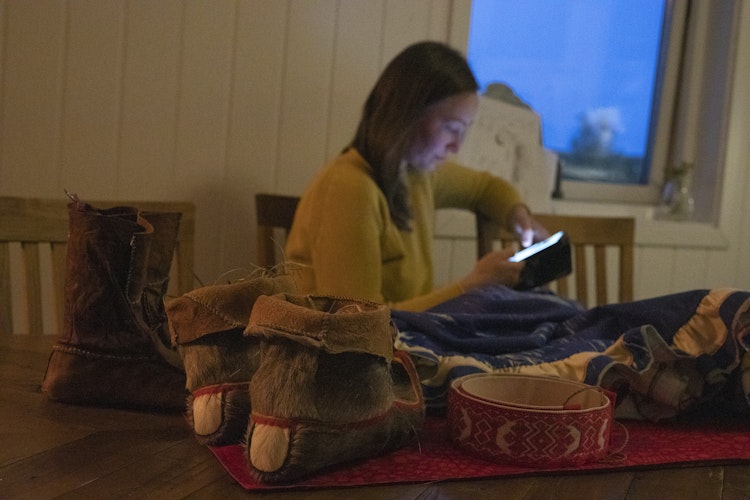
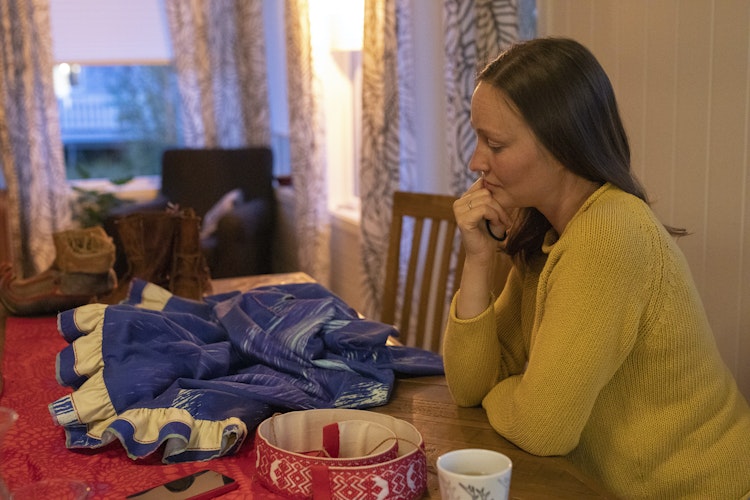
No roots, no feet
Ruija Kvenmuseum, a museum responsible for preserving and mediating Kven and Norwegian-Finnish culture, is located in Čáhcesuolu/Vadsø/Vesisaari.5 It is a department of the consolidated Varanger Museum, which consists of four museums in eastern Finnmark. In August 2021, Ruija Kvenmuseum opened the doors of its new premises (the former broadcasting house) to the public, after a year and a half of renovating the building. Kvens, one of five national minorities in Norway, are descendants of people from Sweden and Finland who immigrated to northern Norway mainly in the 1700s and 1800s.6 For most people living elsewhere in Norway, Kvens are an entirely unknown group. ‘We hope the new exhibition and building can be an arena in which Kvens can exercise their identity and display it through symbols and Kven clothing. It can give a boost to the culture’, says the department head Mia Krogh.
She explains that in the local community, there are interesting processes, innovations and negotiations around Kven identity.7 In the museum’s permanent exhibition, there are, among other things, tools for agriculture and house building – industries in which the Kven immigrants were specialists. Today’s young Kvens revitalise Kven craft, called käsityö, with new products of striped, woven material relating to Kven clothing, and mitten patterns with the sun symbol auringonkukka, which is a central element in the Kven flagg.8 The protection of Kven symbols and objects is not a particularly critical issue at present because the Kvens are only beginning their revitalisation process, so there is little to be commercially exploited. The same cannot be said about duodji and Sámi art and cultural expressions. Parts of the tourist industry in North Finland have been criticised for ‘Disneyfying’ Sámi culture with non-Sámi actors dressed in fake gávttit.9 This has also happened in Norway. Some years ago, a Norwegian supermarket chain gave its employees mass-produced copies of gávttit, sewn in the chain’s signature green. They were meant to be used as party costumes at a branch get-together.10 Reactions from the Sámi community were severe, for the fake gávttit were perceived as mocking both the culture and crafts of the Sámi. This is one reason why the institutions administering Sámi cultural heritage are extremely careful to have visitors to their archives and storage facilities give a precise account of what their visit will lead to, and that they must afterwards give credit to the institution.
Krogh says the museum gladly welcomes artists and others who want to study objects in the storage facilities, persons who need to touch and study details for research or inspiration, but that great care must of course be taken. New technologies also help with the museum’s core activity: making the works accessible to the public. 3D-photography is a technique the museum wants to use in the future, making it possible to take a close-up look at the objects without needing to visit the museum in person.
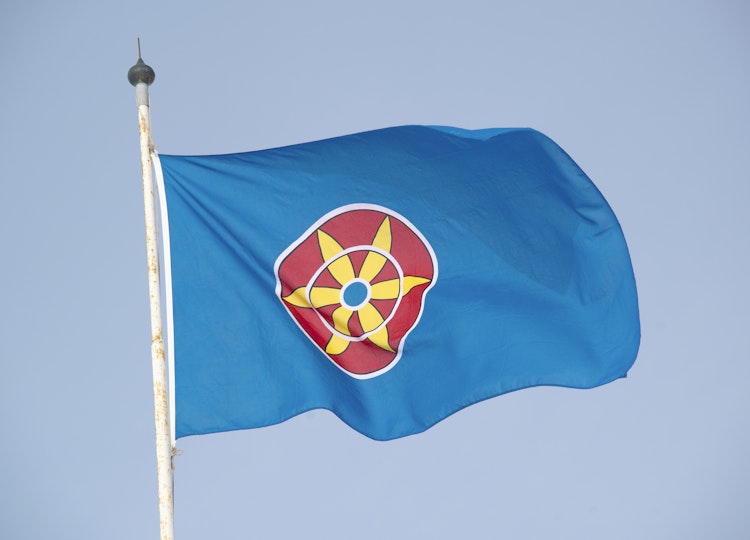

There is no dedicated Kven archive comparable to the Sámi archives in Norway and Finland (although they are subordinate to the national archives). The significance of Ruija Kvenmuseum is therefore enhanced because it has Kven objects in its magazines and exhibition, plus the fact that the museum staff possess much competence in the areas of Kven history and culture. The nation states in Fennoscandia implemented assimilation policies affecting both Sámi and Kvens, but in recent decades these groups have resisted the policy and are finding their way back to their roots through traditional artistic, crafting and cultural expressions, at the same time as they are developing new expressions for their identity. Now, for example, the Kven artists have established their own association, just as the Sámi artists did in the late 1970s.11 For many young people, the concept of ‘Kven identity’ is so new that they can form it relatively freely, without needing to deal with entrenched opinions about what ‘Kven identity’ should contain, or the identity such as their parents’ generation practiced it. For young Kvens, identity is about feelings and a new pride. ‘Many young people wear komager12 instead of shoes, and they weave the accompanying ribbons or use the silver brooches worn with Kven clothing on a daily basis. Some also want to buy Kven objects when they visit the museum shop’, says Krogh.
AIDA
Duojárat, historically speaking, have not donated their works to archives. For the Sámi, traditions and competencies have largely been passed down orally from person to person, as well as through the lifestyle and worldview. What are preserved of the materials, patterns, textile samples, notes and pictures made by duojárat?
In 2017, the Arctic Indigenous Design Archive, AIDA, was established. Three Sámi institutions collaborate: the Sámi archive Saamelaisarkisto in Anár in Finland, Ájtte Svenskt Fjäll- och Samemuseum in Jåhkåmåhkke/Dálvadis in Sverige, and Sámi Allaskuvla in Guovdageaidnu in Norway. Each institution has competence in separate areas. The idea behind AIDA is the brainchild of the designer Inka Kangasniemi, who saw a need for a design archive. Ájtte, on the Swedish side, then elicited opinions from duojárat about the idea. It was resisted: ‘For some, it was unthinkable to donate their materials to an archive; they were apprehensive about how the materials would be used’, says Anna Westman Kuhmunen, project leader at Ájtte.
‘The duodji objects in themselves aren’t the only things that are interesting [for us]; so also are notes, textile samples and objects that turned out wrong, but which nevertheless have not been thrown away, because they also have value. Such materials are important for understanding duodji, craft and artistic practice, and we want to preserve them. We let the artists and duojárat who want to establish an archive with us, choose us, not the other way around’, explains Westman Kuhmunen.
Instinctively, I know that much trust is required to relinquish one’s patterns, handwritten notes and garments that perhaps were sewn incorrectly. I certainly would have difficulty donating creative material that almost comes from my inner being to an institution. What have the people involved in AIDA done to win the trust of duojárat and artists?
‘Coffee drinking is a significant part of the process. It often takes longer than the traditional handover of archival material. Sometimes it takes up to a year and a half from the time when we first establish contact with a duojár to when the archival material is donated, because this archive must be relational. After the delivery, we maintain contact with the donors, precisely in order for it to be a living archive’, says Westman Kuhmunen.
When it comes to private archives, one often works with materials donated by the family of someone who has died. Here, by contrast, we deal with living and active artists and duojárat. The AIDA project has used social media to promote the artists and duojárat who’ve established the archive, and we’re continuously organising activities and exhibitions. The process has been different than for other types of institutions involved in collection and preservation activities, since AIDA has ongoing contact with the donors about their archive, also after they make the donation.
‘AIDA breaks up the established categories that we have at the institutions [that are involved in the AIDA project]. The Sámi archive in Finland normally works with archived materials such as films, texts and photos. A duojár’s archive is different: it most often contains physical objects made of wood, antlers and textiles, depending on what the duojár has made. At Ájtte, we have the advantage of being both an archive and a museum. We can also receive finished works and objects with a different materiality than one traditionally finds in archives’, says Westman Kuhmunen.
Different materials should be preserved under different conditions, for instance as regards temperature and light. But how is it possible to keep a duojár’s archive together when it consists of different categories of materials? Having one storage facility for art, one for duodji and another for paper would split up these materials, so to be able to store everything together has been important for us to achieve, and it’s also important for users of the archive. ‘It can be said to be an indigenising of the process of archiving’, says Westman Kuhmunen.
‘Indigenising also involves breaking apart the [conventional system of] classification for preservation, such that the starting point is the identity of the materials. We are responsible for archiving the material, but we will continue a relational collaboration with the persons who have made donations to the archive’, she says.
During the AIDA project, a curriculum has been developed for the duodji students at Sámi Allaskuvla, and in 2022 a book about the project and its processes will be published. Gunvor Guttorm, professor of duodji at Sámi Allaskuvla, plays a key role in this work. At Sámi Allaskuvla, two research assistants have also been hired, and through the archives, they find inspiration and material for their own artistic practices. ‘One can thus follow the process [of creation] as it unfolds, from inspiration to new works, explains Westman Kuhmunen.
The establishment of such archives can strengthen individuals, families and societies and can be important means for learning. Being able to see a proficient duojár’s flops, for instance works in which the seams have turned out wrong or the wood cracks, can help young people gain unique knowledge about the materials and work processes and give them courage to dare to experiment and make mistakes. The written agreement for a donation to AIDA often includes a clause stipulating that the works representing failed attempts must only be used for teaching. This is something we insert in the individual agreements with each duojár’, says Westman Kuhmunen.
Sohpparjohka
As I now drive from Guovdageaidnu to Kárášjohka, I travel from one north-Sámi centre to another. In Kárášjohka, on an early autumn day, I meet Else Marie Isaksen. The city is home to both Sametinget (the Sámi Parliament of Norway) and the main administration of RiddoDuottarMuseat (RDM). RDM is a Sámi museum foundation in western Finnmark consisting of four museums and one art collection. One of these museums is in Inga Sara Utsi Bongo’s hometown Guovdageaidnu, which is also where we find the Sámi archives in Norway. Another archive in the region is Museet Sámiid Vuorká-Dávvirat/De Samiske Samlinger (SVD) in Kárášjohka,13 which administers over 5,000 objects from Sápmi.
Isaksen and I batter through the penetrating wind to the nearest petrol station to have a chat indoors. Isaksen has been an enthusiastic user of archives for many years. She was previously employed by Sametinget and has published a book on the artworks housed in the parliament. Now retired, Isaksen is on the editorial committee for Kárášjoga Jahkegirji,14 and for the next edition is writing a chapter on the use of birch. She tells me about the time when she took an elderly man, Nils Anders Rasmus, who has worked with wood his whole life, to RDM. ‘While viewing the exhibition, he could identify various old tools and objects, tell me about them, and fill holes in my Sámi vocabulary for a number of things. Afterwards, the museum personnel could search in the archives and give me relevant photo material on a memory stick’, says Isaksen. Books about duodji and family genealogy, plus Facebook groups where people share old pictures, are also very useful for Isaksen’s research, not to mention the good old jungle telegraph. For her research on birch, finds of older objects made of birch are more important than text archives. Isaksen tells me that in a few days she will visit the village of Váljohka, about 50 km from Kárášjohka, to photograph a geres – a sledge made of birch.
After our goodbyes, I get back in the car and continue driving south. Nils Anders Rasmus’s home is in Sohpparjohka, a bit past Váljohka. He has been a widower since his wife died several years ago. They had always worked together, ever since they married in the 1960s. Rasmus describes himself as a veidemann (– a trapper and a forest worker) because he has lived in and with nature since childhood and has always depended on nature for his livelihood. There are several cubic metres of wood in his courtyard, stored both in a large, crooked shed, and in large, carefully built stacks. The forest is close at hand, and below the house is the river. A tractor and wood cleaver are important tools. When I enter his house, the wood stove is stocked with firewood and bark, ready to be lit on the first frosty evening. Rasmus was 12 years old when he built his own river boat, six metres long. At 13 he started working in the forest. ‘I now toy with the idea of retiring, after having worked for almost 70 years’, he laughs. He mentions that he only attended elementary school for 192 days. His father died when he was still a child, but he learned to earn a living in nature from his grandfather and other relatives who were carpenters. Earning money for the family was more important than book learning, even though he later attended a one-year vocational school, took correspondence courses and studied dermatology, albeit always in addition to working outdoors. Rasmus has made duodji, which he has sold to tourists, and he has made boats and various types of sledges and harnesses for both reindeer and horses. For Isaksen he has been an important source of knowledge, especially on the use of birch. By seeing objects in SVD's exhibition, Rasmus could more easily remember how the objects were used and could explain Sámi concepts relating to that use. Not the least important was that he could tell the museum personnel about what was missing from the collection.
‘In the past, in the autumn when it started getting dark in the evenings, we fished with light. We lit a small fire in a container called an áren or hárset, which was placed at the very front of the boat, in the bow, and we speared the fish that were attracted to the light. The museum lacks fishing spears and the áren in which the fire is lit’, says Nils Anders Rasmus, who himself owns such a tool. The reason why is that Sohpparjohka and Váljohka are two of the very few places that were not destroyed at the end of the Second World War, so there are still a few buildings and objects here from before 1944. I thank him for the coffee and say goodbye after taking some pictures of him in his courtyard. Work has kept this 82-year-old fit and in good spirits. He is fortunate to have been able to live in harmony with the traditions and knowledge passed down through his family, and in the same area in which he was born.
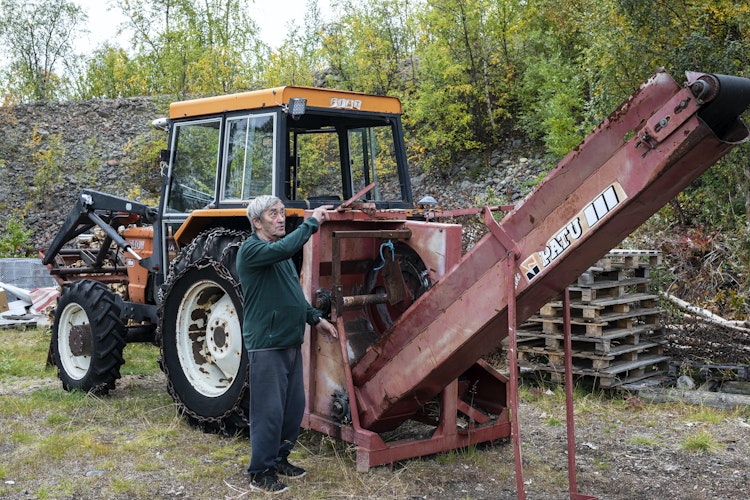
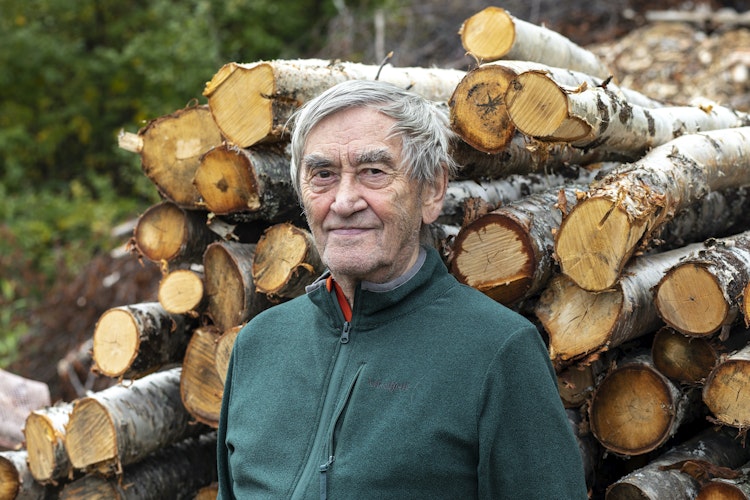
The car transports me through our landscapes, from the plateau where Siebe and Guovdageaidnu are located, through the forests around Kárášjohka and Sohpparjohka, along the Deatnu River and out to Várjjat, the large fjord alongside where I now live. I think about Sara Inga Utsi Bongo and what she told me about making duodji when we talked on the phone the first time: ‘Duodji is a lifestyle; it involves sensing and being a part of the whole process. To create fills life with value; it is meditative, but it also gives energy.’
When I started preparing to write this article, I thought about Siebe on the plateau Finnmarksvidda, my heart’s home. It is my heart’s home because it is the place from which my family comes, where I seek calm and where I feel at home, even though I was not born there or have ever lived there. An emotional connection to a place and an area is necessary for feeling whole and in harmony with oneself and one’s existence. To know the trees, heather, animals, bodies of water, fish, berries and insects – even though one perhaps otherwise lives far removed from nature – provides good ground for the roots needed under one’s feet, and a deeper form of meaning when working, travelling and encountering other peoples and cultures with a modern, nomadic lifestyle. Although I myself have not learned to make duodji objects, I can still understand a life with duodji because it is inextricably tied to an area, a tract of land in both a direct and a figurative sense. I own nothing from this area made before 1944, but I know such things exist, and I need to see them, know them, and smell them. This is why I am drawn to museums that can tell me about our life and our forefathers’ and foremothers’ lives. The voices from another time speak, both wordlessly and through texts, to those of us who are alive today, and we can use them to create new things.